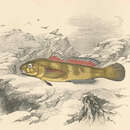Diagnostic Description
provided by Fishbase
Neck naked. No black spots in the front end of each dorsal fin (Ref. 35388).
- Recorder
- Arlene G. Sampang-Reyes
Life Cycle
provided by Fishbase
Oviparous (Ref. 205). Male guards the eggs deposited by the female under rocks or inside empty bivalve shells until they hatch (Ref. 45332). Larvae remain near the substrate until they assume the cryptobenthic behavior of the adults (Ref. 45332). Are repeat spawners (Ref. 4696).
Migration
provided by Fishbase
Amphidromous. Refers to fishes that regularly migrate between freshwater and the sea (in both directions), but not for the purpose of breeding, as in anadromous and catadromous species. Sub-division of diadromous. Migrations should be cyclical and predictable and cover more than 100 km.Characteristic elements in amphidromy are: reproduction in fresh water, passage to sea by newly hatched larvae, a period of feeding and growing at sea usually a few months long, return to fresh water of well-grown juveniles, a further period of feeding and growing in fresh water, followed by reproduction there (Ref. 82692).
Trophic Strategy
provided by Fishbase
Common inshore and intertidal species, under stones and in pools on sheltered rocky shores with much weed cover (Ref. 122774). Also found on seagrass beds (Ref. 122775).
Biology
provided by Fishbase
Predominantly marine, but may enter freshwater. Adults occur inshore in intertidal waters, under stones and in pools on sheltered rocky shores with much weed cover. Macrobenthos feeder on hard substrates (Ref. 92840), they feed on crustaceans (larger amphipods, isopods, small crabs) and polychaetes; juveniles eat harpacticoid copepods, amphipods, polychaetes and mites (Ref. 4696). Oviparous (Ref. 205). Fusiform shaped eggs are found in patches of several thousand on undersurface of stones, shells, polychaete tubes or Ciona mantles (Ref. 4696).
Importance
provided by Fishbase
fisheries: minor commercial; aquarium: public aquariums; price category: very high; price reliability: very questionable: based on ex-vessel price for species in this family
Rock goby
provided by wikipedia EN
The rock goby (Gobius paganellus) is a small coastal goby of eastern Atlantic waters, from Scotland to Senegal.[2] It is also reported from the Mediterranean and Black Seas, and is an anti-Lessepsian migrant in the Gulf of Eilat and Red Sea. There are unconfirmed records from the area around Pointe Noire in Congo-Brazzaville.[3]
Description
The rock goby is usually black with white blotches, but they can change color, and males are much more black when guarding the eggs. The neck area lacks scales and there is a pale band on the top of the first dorsal fin. Both dorsal fins lack black spots on their leading edges. This species can reach a length of 12 centimetres (4.7 in) TL and has been known to live for ten years.[3]
Distribution and habitat
The rock goby is found in the temperate East Atlantic and the Mediterranean Sea. Its range extends from western Scotland southwards to the Azores and Senegal, most of the Mediterranean Sea and the Black Sea. It sometimes migrates through the Suez Canal to the Red Sea and the Gulf of Aqaba. It prefers rocky sea floors below the low tidemark, although it can be found in larger rock pools in Summer. It may also live in fresh or brackish water. It can be found at depths of from 0 to 15 metres (0 to 49 ft).[3]
Behaviour
The rock goby eats small crabs and amphipods, polychaetes, larva, small fish, Calanus, copepod, and mites.[3]
Reproduction
The rock goby reproduces in spring. It nests in rocky areas near the kelp forest, Up to 7000 eggs are laid, in a single layer, under rocks and shells. The eggs (up to 7000) are laid in a single layer (2.5 mm in height) and guarded aggressively by the male. The eggs hatch in about 19 days.
References
-
^ Carpenter, K.E.; Smith-Vaniz, W.F.; de Bruyne, G. & de Morais, L. (2015). "Gobius paganellus". The IUCN Red List of Threatened Species. 2015: e.T198662A21913408. doi:10.2305/IUCN.UK.2015-4.RLTS.T198662A21913408.en.
-
^ Miller P.J. (1986) Gobiidae. In: Whitehead P.J.P., Bauchot M.-L., Hureau J.-C., Nielsen J., Tortonese E. (eds.) Fishes of the North-eastern Atlantic and the Mediterranean, Vol. 3. UNESCO, Paris.
-
^ a b c d Froese, Rainer; Pauly, Daniel (eds.) (2013). "Gobius paganellus" in FishBase. June 2013 version.

- license
- cc-by-sa-3.0
- copyright
- Wikipedia authors and editors
Rock goby: Brief Summary
provided by wikipedia EN
The rock goby (Gobius paganellus) is a small coastal goby of eastern Atlantic waters, from Scotland to Senegal. It is also reported from the Mediterranean and Black Seas, and is an anti-Lessepsian migrant in the Gulf of Eilat and Red Sea. There are unconfirmed records from the area around Pointe Noire in Congo-Brazzaville.
- license
- cc-by-sa-3.0
- copyright
- Wikipedia authors and editors

